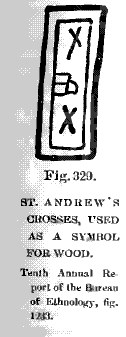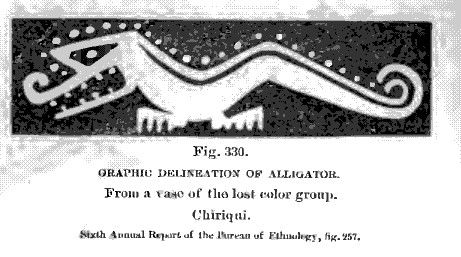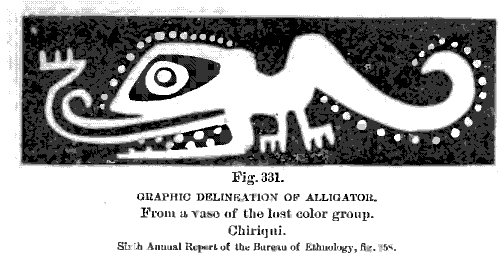

The Swastika
The Cross Among The American Indians
 having
the appearance of conventionalized wings similar to some representations
of the thunder bird of the northern tribes; yet the same author, in his
paper on the study of the "Troano Manuscript," (2)
gives fig. 329 as a symbol for wood, thus further showing the manifold
concepts attached to the general form of the cross. Bandelier thinks that
the cross so frequently used by the aborigines of Mexico and Central America
were merely ornaments and not objects of worship, while the so-called
crucifixes, like that on the Palenque tablet, were only the symbol of
the "new fire," or the close of the period of fifty-two years.
He believes them to be representations of the fire drills more or less
ornamented. Zamacois (3) says
that the cross was used in the religion of various tribes of the peninsula
of Yucatan, and that it represented the god of rain.
having
the appearance of conventionalized wings similar to some representations
of the thunder bird of the northern tribes; yet the same author, in his
paper on the study of the "Troano Manuscript," (2)
gives fig. 329 as a symbol for wood, thus further showing the manifold
concepts attached to the general form of the cross. Bandelier thinks that
the cross so frequently used by the aborigines of Mexico and Central America
were merely ornaments and not objects of worship, while the so-called
crucifixes, like that on the Palenque tablet, were only the symbol of
the "new fire," or the close of the period of fifty-two years.
He believes them to be representations of the fire drills more or less
ornamented. Zamacois (3) says
that the cross was used in the religion of various tribes of the peninsula
of Yucatan, and that it represented the god of rain.It is a favorite theory with Major Powell, Director of the Bureau of Ethnology, that the cross was an original invention of the North American Indian, possibly a sign common to all savages; that it represented, first, the four cardinal points, north, south, east, and west; and afterwards by accretion, seven points, north, south, east, west, zenith, nadir, and here.
Capt. John G. Bourke, in his paper on the "Medicine Men of the Apache" (4) discourses on their symbolism of the cross. He says it is related to the cardinal points, to the four winds, and is painted by warriors on their moccasins when going through a strange district to keep them from getting on a wrong trail. He notes how he saw, in October, 1884, a procession of Apache men and women bearing two crosses, 4 feet 10 inches long, appropriately decorated "in honor of Guzanutli to induce her to send rain."

Some very ingenious theories have been elaborated in attempting to account for the cross among American symbols. Brinton believes that the great importance attached to the points of the compass --- the four quarters of the heavens --- by savage peoples, has given rise to the sign of the cross. With others, the cross is a phallic symbol derived, by some obscure process of evolution, from the veneration accorded to the procreative principle in nature. It is also frequently associated with sun worship, and is recognized as a symbol of the sun --- the four arms being remaining rays after a gradual process of elimination. Whatever is finally determined in reference to the origin of the cross as a religions symbol in American will probably result from exhaustive study of the history, language, and art of the ancient peoples, combined with a thorough knowledge of the religious conceptions of modern tribes, and when these sources of information are all exhausted it is probably that the writer who asserts more than a probability will overreach his proofs. * * * A study of the designs associated with the cross in these gorgets [figs. 302, 303 and 304] is instructive, but does not lead to any definite result; in one case the cross is inscribed on the back of a great spider [figs. 275, 276, 277 and 278]; in another it is surrounded by a rectangular framework of lines, looped at the corners and guarded by four mysterious birds [figs. 263, 264, 265, abd 266], while in others it is without attendant characters, but the workmanship is purely aboriginal. I have not seen a single example of engraving upon the shell that suggested a foreign hand, or a design, with the exception of this one [a cross], that could claim a European derivation. * * * Such delineations of the cross as we find embodied in ancient aboriginal art, represent only the final states of its evolutions, and it is not to be expected that its origin can be traced through them.

Of all the animal forms utilized by the Chiriquians, the alligator is the best suited to the purpose of this study, as it is presented most frequently and in the most varied forms. In figs. 257 and 258 [figs. 330 and 331 in the present paper] I reproduced drawings from the outer surface of a tripod bowl of the lost color group. Simple and formal as these figures are, the characteristic features of the creature --- the sinuous body, the strong jaws, the upturned snout, the feet, and the scales --- are forcibly expressed. It is not the be assumed that these examples represent the best delineative skill of the Chiriquian artists. The native painter must have executed very
ENDNOTES:
1. Second Ann. Rep. Bureau of Ethnology, p. 61. [Back]
2. Contrib. North American Ethnology, V, p. 144. Back
3. "Historia de Mexico," I, p. 238. Back
4. Ninth Ann. Rep. Bureau of Ethnology, 1887-88. p. 479. Back
5. "Myths of the New World," p. 96. Back
6. "Gaspesi," London, 1691, pp. 170, 172, 199. Back
7. Second Ann. Rep. Bureau of Ethnology, 1880-81, p. 270. Back
8. Sixth Ann. Rep. Bureau of Ethnology, p. 173 et seq., figs. 257-278. Back
<< Previous Page Next Page >>
© 2004-2007 Northvegr.
Most of the material on this site is in the public domain. However, many people have worked very hard to bring these texts to you so if you do use the work, we would appreciate it if you could give credit to both the Northvegr site and to the individuals who worked to bring you these texts. A small number of texts are copyrighted and cannot be used without the author's permission. Any text that is copyrighted will have a clear notation of such on the main index page for that text. Inquiries can be sent to info@northvegr.org. Northvegr™ and the Northvegr symbol are trademarks and service marks of the Northvegr Foundation.

|